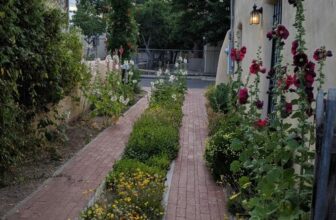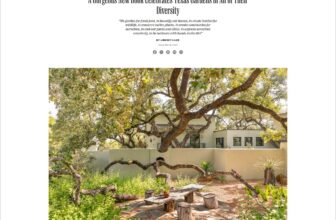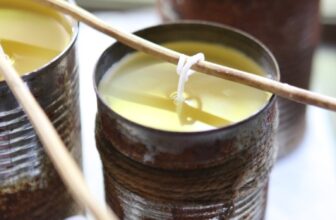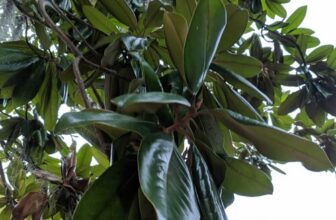
Ken is author of 20 garden books, and gardens in a mostly shady spot in New Jersey, where foliage is a major driver that makes his extensive landscape design work. Whether for herbaceous plants closer to ground level or in his tree and shrub choices, he’s always on the lookout for the unusual selection of a particular plant that has that something extra: great leaves (like Ken’s red-leaf peach, above).
Read along as you listen to the July 21, 2025 edition of my public-radio show and podcast using the player below. You can subscribe to all future editions on Apple Podcasts (iTunes) or Spotify (and browse my archive of podcasts here).
foliage, the garden’s mainstay, with ken druse
Download file | Play in new window |
Subscribe: Apple Podcasts | Spotify
Margaret Roach: Hi, Ken. How are you?
Ken Druse: Hello, Margaret. I am fine. A little bit warm.
Margaret: Toasty [laughter]. Toasty. Are we toasty?
Ken: Both sides?
Margaret: Yeah, exactly, it’s been hot. I guess the whole country, everybody’s struggling with one thing or another, in some places much worse, of course, than just hot.
Ken: One thing or another. Exactly.
Margaret: So just to sort of set the scene, spring is flowers, flowers, flowers, I think. I feel like the trees are flowering, and the perennials are flowering, the bulbs are flowering. There’s a lot. And then I don’t do a lot of “annual color” for summer. I don’t know about you. I have a few pots, but not much.
Ken: A few pots. Exactly. And as you said, it’s shady here, but there’s a little patch of sun and that’s where the daylilies are. I mean, the orange daylilies on the roadside will bloom in some shade, but I don’t even want those. But the fancier daylilies are in this little bit of sun, and they’re kind of over. They’re ending, if anything. And this is the lull, the July lull, the I guess midsummer lull, which happens every year in between those daylilies and maybe when the summer Phlox starts blooming. So it’s a quiet time, but here it’s time for leaves.
Margaret: It’s funny, my tall Phlox, the Phlox paniculata, have started. They’re already doing their thing. So it depends on which variety you have, and what I was thinking of with the daylilies as well, you could have many, many, many weeks of daylilies if you wanted to devote tons of space and have however many different varieties that were early, middle, and late-season among daylilies or whatever. But in an average space, we’re going to have a kind or two, a variety or two, and so we’re going to have not the maximum possible season we could from a particular species of plant.
Ken: I’ve got about 15 feet at the front edge of a border, which is where the daylilies are, and that’s about it.
Margaret: And again, if you had 20 different kinds, you might have a longer bloom, but you wouldn’t have the mass that you have [laughter].
But the other thing I find flower-wise that does make me feel happy at this time as the summer heats up, is there’s a lot of shrubs and trees that do have white flowers that I feel refreshed by in a way. The hydrangeas start; the oakleaf hydrangeas, for instance, have been blooming here for a couple of weeks, and just those big white flowers. And I have a big, big stand of elderberry, native elderberry, and it just looked beautiful; I can see it all from the window all the way across the garden. It was just covered in white flowers, and that feels nice.
Ken: It’s even cooling.
Margaret: Yes. Yes.
Ken: It looks cooling [laughter].

Margaret: But I don’t plant a lot of summertime flowers. Again, I have a big mass of Phlox in one spot, but it’s not like I’m not operating a flower garden, so to speak. It’s more of a foliage-dominated landscape. And I think yours is similar, and yours is even more structural in a way. You use a lot of shapes of plants as well. You’re very particular about… You have some very dramatic columnar elements and other things like that that look good all the time. [Above, Ken’s foliage-dominated landscape.]
Ken: It’s really just because in love with them [laughter]. It sounds like I’ve planned it, but well-
Margaret: Well, unconsciously maybe.
Ken: Well, sometimes I’ll move something, or I realize that something spiky might stop you in your tracks, and something low and wide might be feel cooling or lead you to a place to sit or something. There are things that you can do with foliage, and I love the contrast and the textures and forms, and gee, I’m just in love with them [laughter].
Margaret: So you just said “lead you to a place,” and I think that’s an important part of what foliage can really do over a long season. If something has its leaves from—where we live—from May until October or whatever, that’s a long season, longer than almost anything’s going to bloom. And it can lead you to a place, like you said; lead the eye.
And friends, years and years ago, helped me to be more deliberate about my thing, which is gold foliage—about sort of placing gold elements, elements of gold foliage, shrubs and trees—on axis from key vantage points, like windows or places that I sat and looked out at the garden. They sort of say, “come hither,” and pull me out, pull my view out, catch my eye all the way out to the extreme ends of the garden and make these, as I said, axial views, lined along the way here and there by a gold element. Is that how you use it, too?
Ken: Pretty much, just like you said, to catch your eye or to bring your eye to a place. And then in contrast to that, to not have the gold up close maybe, so that it does have the impact and be kind of theatrical, right?
Margaret: Because gold definitely comes forward toward you. Right? It’s a screamer [laughter].
Ken: And variegation, too. When it’s white-on-green, it lights up. Sometimes in some of the darker places, we’re lucky enough to have gold do that.
Margaret: It advances. And whereas if you use dark purple foliage, it’s a little bit more of anchoring, receding, a little heavier. I feel like it doesn’t scream as much as it feels weightier to me. Does that make sense?
Ken: Yeah. I’m thinking about how much one can blend these colors of the foliage, have the red go to reddish-green, go to green, go to green, go to gold. You can really make sort of spectral arrangements.
Margaret: Yeah. So maybe let’s talk about some specific plants that you use or I use and start with gold, sure. I think that’s the most insistent one of all. And I may have overdone it [laughter], but that’s one. Are there some that you really are glad to have in the garden as you look out right now, at this time of year?

Margaret: That’s a great plant. What about shrubs and so forth? I have some gold and conifers and some of them have gotten quite large. I have a couple of the big metasequoias, the dawn redwoods, I guess they are called the ‘Gold Rush’ variety, that are deciduous conifers. I have them up on the hill, so you can kind of look up the hill and they call out to you, so to speak, from a distance.
Ken: And they’re really gold for you? I mean, they really have color on the leaves?
Margaret: Yeah. ‘Gold Rush.’ Yeah.
Ken: Well, regular conifers that are evergreen, I just don’t have enough sun for most of those. I do have Metasequoia, and I do have water. That’s one thing I have is groundwater, and they love that, so they grow really fast. But I have ‘Ogon,’ which is the same, I think, as ‘Gold Rush,’ actually.
Margaret: Yeah. I think it may be ‘Ogon,’ and I am translating it.
Ken: You can hardly tell that it’s different from the other ones.
Margaret: Oh.
Ken: It does very well, but it’s not so gold when you don’t have more sun.
Margaret: Yeah, I would say it’s not a screamer. I have also some of the Chamaecyparis, for instance, the cultivar called ‘Crippsii’ of Hinoki cypress, Chamaecyparis obtusa ‘Crippsii.’ And they’ve gotten very big, because I’ve been here a long time, they’re like trees now. And they are very gold, compared to the metasequoia. And they are evergreen conifers. And so those are things that I am glad to always have.
And then I have a lot of deciduous things, especially shrubs. They’re gold. Like a gold-leaf mock orange shrub and a gold Spiraea ‘Ogon,’ speaking of that word “ogon,” that Japanese word for gold. That’s a variety name of a lot of things that are at a distance, again, on an axial view from a particular window. And it’s like I just look out and there they are, the sentinels.
Ken: Well, I have a plant that’s kind of new to me, which is Leucosceptrum japonicum ‘Golden Angel.’ [Below, at Ken’s.]

Ken: Herbaceous, and it’s a mint family member. Well, it’s not out of control, but it’s a nice clump. I could make a hedge out of it. And it’s in quite a bit of shade. And it’s gold.
Margaret: I have that, too. I got it from Broken Arrow Nursery a number of years ago, and I have a big stand of it now.
Ken: You know what it looks like? It looks like pokeweed, sort of, the leaves.
Margaret: And there are gold pokeweeds, among native things, perennials; I guess pokeweed is a perennial, I don’t know, it’s sort of an odd creature.
Ken: It is odd, because sometimes it’s not where you put it the next year.
Margaret: Well, it definitely sows around, but there are gold selections of it, too, besides the straight green that’s the straight species. Do you have any different ones?
Ken: Well, yeah, I have a gold one that looks like it’s splashed with green [below]. It’s really magnificently beautiful. I’m always sorry, kind of, that the birds like it so much.
Margaret: Oh, they move it around [laughter].
Ken: But it comes true from seed. A lot of these plants don’t; a lot of things that have variegation, when they sow, they come up green, unfortunately.
Margaret: Right. And there’s a variety that you can get seeds for that’s completely gold, called ‘Sunny Side Up,’ I think, that’s really screaming gold. And it can get to 6 or 7 feet, a pokeweed.
Ken: Woo.

Ken: And they’ll stain your hands [laughter].
Margaret: Indeed, indeed, indeed.
Ken: Beautiful color.
Margaret: So key placement of some gold things, and variegated also, it’s going to again advance visually, to feel like it’s pulling you closer and act like a beacon to a spot, that’s maybe farther away.
Ken: And variegated can be yellow and green, or splashed with green like that Phytolacca, or white and green or gray-green. Sometimes it starts out gold and green, and then changes to cream and green. I have a wonderful tree, Cornus controversa ‘Variegata.’ Remember how we all wanted that plant years ago? Oh gosh. Mine is over 30 years old now. It’s sort of like a wedding cake tree; it’s in tiers.
Beautiful. But there’s native ones, too. I have a wonderful Cercis canadensis called ‘Silver Cloud’ [below]. There’s a couple of variegated ones, and the leaves are almost white, and sometimes I wonder how it’s alive.

Ken: Right, a redbud, and it actually has the same flowers, but the leaves are practically white and heart-shaped. It’s very pretty. There’s a couple of them.
Margaret: This past year, in a place where I had years ago a red-leaved barberry, which of course we’ve all gotten rid of all our barberries because we’ve learned how damaging Berberis are to the environment, the wider environment, as birds move the fruits around into woodlands and so forth. I had this empty space, and I wanted that purpley-reddish color again. And I got a Cercis, a weeping Cercis that I think is called ‘Ruby Falls.’
Ken: I think you’re right.
Margaret: Yeah. And it’s interesting to watch it start to shape up it. It’s just settling in still, but it’s pushing, it’s starting to take off a little bit, so that’s going to be fine.
Ken: It’s dark red, wine-red, kind of like ‘Forest Pansy.’
Margaret: Yes, yes. Exactly. Exactly. So that’s going to be fun to have that take shape, and in that color. I also love a very old ninebark I have, the one that’s called ‘Diabolo,’ and that really attracts attention at a distance. Even though it’s dark-colored and recedes in a sense, visually it’s big and bodacious [laughter].
Ken: It’s like Zone 2 or something. It’s really super-hardy.
Margaret: Really, yeah, are they Northwestern natives?
Ken: I don’t know. I’ve seen them in Canada.
Margaret: Yeah, exactly. But I think they’re western [Correction: there is a Western species, but the more common one, opulifolius, is Eastern North American]. Beautiful. There’s a lot of choices of ninebark. There’s gold ninebark, ‘Dart’s Gold’ is one of the originals. I’ve had that forever.
Ken: A dwarf one that looks just like it, I can’t exactly remember.
Margaret: But those are the kinds of things that you can think about to add.
Ken: Those are just plant-’em-and-forget-them things. Those are great for the outer edges of the property.
Margaret: Yeah. And with some of my older ones, I’ve cut them back; I’ve cut them back to the ground, rejuvenated them, so to speak, if they’ve gotten too big or whatever, I’ve rejuvenated them even more than once. So they’re very tough creatures.
Ken: In Canada, a lot of people, for some reason, grow them as low hedges and prune them. And so in Montreal, you can drive around and see low hedges in front of almost every house, of gold.
Margaret: Well, that would be gorgeous.
Ken: I don’t know how that happened [laughter].
Margaret: Oh, interesting. So Physocarpus as a hedging plant. Huh. Interesting.
Ken: I know I’ve told you about my red peach that I’m so interested in [photo, top of page]. There are a lot of red-leafed peaches, and I have a red-leaf peach that I use as a cutback because it keeps pushing great, gorgeous new red growth. And now you’re getting me thinking about so many things. I’m thinking about Cotinus ‘Grace.’ Do you grow that?
Margaret: So the various smoke bushes and smoke trees. Yes. And I do have a Cotinus ‘Grace’ in a spot where I lost a Korean maple right by the driveway when you first come in. And I put a Cotinus ‘Grace’ in there and it’s just starting to shape up finally after a few years. But it’s indescribable really the color. I don’t even know what color to say I think those leaves are, do you? [Laughter.]
Ken: I say blue-green, and the new growth is kind of reddish, pinkish-orange and-
Margaret: Exactly. So you’re basically saying it’s a kaleidoscope.
Ken: I think it’s a hybrid with an American Cotinus [note: it’s a cross between Cotinus ‘Velvet Cloak’ and the native Cotinus obovatus].
Margaret: Yes, it is. And mine’s flowering, and so it has those frothy kind of foam of flowers as well.
Ken: Well, I don’t let mine flower because I want the foliage, and I cut it back. Usually I cut it back to about 2 feet every other year, but every eight years right to the ground, and then leave it alone for a couple of years. And it goes to 4 or, well, it’s a big plant. It can go to 8 feet, I think.
Margaret: Oh, well, this one’s much bigger than that because I’m not cutting it back. I’m trying to fill a space where a big-
Ken: Oh, the flowers, right?
Margaret: Yeah. So it’s pretty big. It’s probably 12 feet or so high right now.
Ken: We’re talking about tall things and big things, and all of a sudden it comes to my mind that there are very good groundcovers, too.
Margaret: Oh, of course. Of course. Yeah. Yeah. But before we go any further in color, I don’t want to run out of time. The other element—and by some of the examples we’ve been giving we’ve been alluding to it but not saying it out loud—is texture. I mean, that’s the other thing is to sort of paint these pictures with textures, right?

Margaret: Right? It is like naked; there’s no other sense that there’s a plant but this spike with these tiny little flowers, these assortments of little tiny flowers on it, comes up out of the ground [laughter]. It’s crazy.
Ken: And then it fades, and then the leaves come up.
Margaret: And they’re giant. I think it’s called the umbrella plant or something. And well-named, right?
Ken: It has a wavy edge. And for me, about every third or fourth year, I get the fall color, which is spectacular.
Margaret: I don’t get that.
Ken: Sometimes the leaves just turn brown. But some years I get red I can hardly believe; it has great, great color. There’s another native plant that has big leaves, Diphylleia cymosa [below]. You know that plant?
Margaret: Yeah. I’ve grown it for a long, long time.
Ken: Really?
Margaret: I don’t get fall color. I’ve had it for more than 20 years.
Ken: I don’t think it has fall color. Do you get berries?

Ken: North Carolina? [Note: It’s native to the Blue Ridge Mountain region of the Southeast, including North Carolina.]
Margaret: And I want to say I probably got it from like Plant Delights, or maybe it was from Heronswood out in Seattle back in the day or something. I don’t know. But someone put it forth years and years and years ago. And I think in my climate, I should have given it a little more light, a little more sun. That’s the thing with a lot of things from the Southeast, when you bring them up into a cooler region, you could have given them a little more light.
Ken: And vice versa because sometimes heat equals light. I think some things that are growing in shade, I’ll put with the west-setting sun, because they want a little more light instead of heat. Although now we have so much heat.
Margaret: Yes. Now we do live in Atlanta [laughter].
Ken: I tried to grow Diphylleia cymosa, I call it a three-strike plant, because I had to move it. And finally I found a place in a lot of shade actually here. And it’s alive. It’s not fantastic. And it is terrible because I love that plant. I love the flowers and the fruit, it’s beautiful.
Margaret: It’s a beautiful plant.
Ken: Yeah. And another plant I get really, I was going to say angry about, is Astilboides. I cannot grow Astilboides.
Margaret: And I got that, as I’ve said many times on the show, it probably, oh gosh, it’s got to be 30 years ago at a local botanic garden or nearby botanic garden that was on the route where I used to drive every weekend from the city to upstate for the weekends. And I stopped in; they had a plant sale. I stopped in and I bought that. And also one of the Rodgersia, another big-leaf plant. They had both of them in the botanic garden. And I plopped them in, didn’t know what I was doing, and I mean, they’ve just been forever and lusty and whatever. And it has a big—speaking of something that should be called the umbrella plant that is a paler green than the Darmera, but is bigger, even a bigger leaf across, the diameter of the leaf.

Margaret: Oh, good. So let’s talk about some of the tender ones in the last minutes here real quick. Yeah, good idea.
Ken: I try to grow Colocasia, which go dormant, and I can never do it. Some of those have black leaves that are gigantic, like 2-foot arrowhead leaves.
Margaret: So these elephant ears that don’t persist in the winter like a houseplant, right?
Ken: I don’t know; I just can’t carry them over. And Xanthosoma is related and that has chartreuse leaves, but the Alocasia have been doing really well for me, especially carrying them over in the sunroom, where it goes down to about 55 degrees. And I just am growing one, this is the second year I guess, called ‘Dark Star’ [above on bench at Ken’s]. It has arrow-shaped leaves. It’s really big, but it fits in a pot, and it has black stems. It’s so beautiful. Amazing thing is over the winter, usually they get mealybug or red spider or the leaves just get tattered, and then when you bring it back out, it throws out a flush of new growth. ‘Dark Star’ didn’t miss a beat. It was beautiful right through the winter.
Margaret: Well, we’ve run down our time, but between that, that’s a great way to finish, because I think even though we both said we don’t grow a lot of annual flowers, we both do have “investment plants” that we stashed either in our sunrooms or the basement or whatever. The other one being the pineapple lilies, Eucomis, to put up in pots. So I will talk to you again soon, yes, yes?
Ken: Thank you, Margaret.
Margaret: Thank you very much for some inspiration to get through the dog days.
prefer the podcast version of the show?






